
Formulation and Quality Control of Readily Dissolving Drink Powder from Antidesma ghaesembilla Fruits
Pongtip Sithisarn*, Wandee Gritsanapan and Somboon JateleelaPublished Date : 2019-08-24
DOI : 10.12982/CMUJNS.2015.0073
Journal Issues : Number 1, January- April 2015
ABSTRACT
Antidesma ghaesembilla Gaertn, known as “mamao” in Thai, is a plant with edible purple compound fruits. This experiment was conducted to investigate the 1,1-diphenyl-2-picrylhydrazyl (DPPH)-scavenging activities of extracts from the fruits of mamao prepared by different methods of extraction and drying, and to quantitatively analyze the total phenolic content and the total anthocyanin content. Decoction and drying by evaporating the extract of mamao ripe fruits promoted the extract with the strongest free radical scavenging activity (IC50 = 72.42 ± 3.52 μg/ml), with high amounts of total phenolic content and total anthocyanin content of 1.22 ± 0.36 g gallic acid equivalent in 100 g extract (g%GAE) and 7.09 ± 0.24 g cyanidin-3-glucoside equivalent in 100 g extract (g%C-3-GE), respectively. This extract was developed as a readily dissolving drink powder by a wet granulation method and qualitatively controlled by evaluations of loss on drying, thin layer chromatographic (TLC) and infrared spectroscopic (IR) fingerprints. The obtained product was observed to be a pinkish-red powder that contained 3.08 ± 0.81 g%C-3-GE in 1 sachet (14 g) and exhibited free radical scavenging activity equivalent to 0.004 g of vitamin C.
Keywords: Antidesma ghaesembilla, Mamao, DPPH scavenging activity, Total phenolic, Total anthocyanin, Readily dissolving powder
INTRODUCTION
Many degenerative pathologies and diseases, including cardiovascular diseases, Alzheimer’s, atherosclerosis, inflammation and cancer, are related to the excess production of free radicals (Cross, 1987). To balance free radicals in the body, consuming antioxidant diets, including fruits and vegetables, could help control oxidative stress in humans. Various edible plants in Thailand, such as Gymnema inodorum, Piper sarmentosum and Mentha arvensis, have been reported to promote in vitro antioxidant activities (Chanwitheesuk et al., 2005). Some Thai vegetables and fruits were also investigated for free radical scavenging capacities and phenolic contents (Maisuthisakul et al., 2007). In Thailand, herbal drinks from plants such as Hibiscus sabdariffa, Chrysanthemum indicum and Aegle marmelos have been popular because of their tastes and odors (Kruawan and Kangsadalampai, 2006). Some herbal drinks, including teas from Andrographis paniculata, A. marmelos and C. indicum, also promote an antimutagenic effect (Kruawan and Kangsadalampai, 2006). Moreover, stevia (Stevia rebaudiana) and sappan (Caesalpinia sappan) herbal teas have been observed to exhibit antioxidant and anti-glycation effects, comparable to teas from Camellia sinensis, while purple velvet (Gynura divaricata), mulberry (Morus alba) and false mallow (Malvastrum coromandelianum) herbal teas have been found to promote stronger metal chelating capacities than the C. sinensis teas (Deetae et al., 2012). These previous reports indicate the high interest and the continued growth in the development of health products, especially herbal drinks, in Thailand. Antidesma ghaesembilla, which is known as “mamao” in Thai, is a medicinal plant belonging to the Euphobiaceae family. The tree of this plant grows up to 20 m in height and has simple alternate leaves and multiple fruits (Homhual, 2014). The leaves and fruits have been traditionally used to treat anemia and promote blood circulation, while the bark has been used as an astringent and tonic (Homhual, 2014). The roots of mamao are also used to treat aphthous ulcers in southern Thailand (Neamsuvan et al., 2012). The dark purple ripe fruits of mamao have been developed to prepare various nutritional products, such as wines, jams and fruit juices (Kermath et al., 2014). Although mamao fruits offer various nutritional applications, there have been no reports of its biological activities and phytochemicals. Therefore, this study was set up to investigate the antioxidant activity of the extracts from the fruits of mamao, using the DPPH scavenging assay, and to quantitatively analyze the active components, including the phenolic content and the anthocyanin content, by Folin-Ciocalteu and pH differential methods, respectively. Additionally, investigation of suitable methods for fruit extract preparation, such as extracting and drying methods and product development, were also conducted.
MATERIALS AND METHODS
Plant materials
Purple (ripe) and red (raw) fruits of mamao (A. ghaesembilla) were collected from Nong Khai Province, Thailand, in January 2012. The plant materials were identified by Assoc. Prof. Dr. Wandee Gritsanapan, Department of Pharmacognosy, Faculty of Pharmacy, Mahidol University, Bangkok, Thailand. The samples were cleaned and air dried, after which the seeds were removed and the flesh was cut into small pieces. The ripe and raw fruits were separately extracted and dried using different extracting and drying procedures as listed below.
Decoction
The flesh of ripe fruits of mamao was boiled (80°C) with distilled water (plant/water ratio of 1:10 w/v) for 8 h, and then filtered. The filtrate was dried by spray drying using a Buchi Mini Spray Dryer B-290 (Buchi, Switzerland) with the inlet temperature at 130°C and outlet temperature at 114°C, freeze drying using a Christ Alpha 1-4 LSC freeze dryer (SciQuip Ltd., UK) at a temperature of -45°C and a pressure in the range of 0.200-0.400 mbar, and evaporation on a water bath (Memmert, USA) at a temperature of 60°C to obtain the dried ripe fruit decoction extracts of spray drying, freeze drying and evaporation (PDS, PDF and PDE), respectively. The raw fruits of mamao were also extracted using the same decoction protocol by freeze drying to obtain a raw-fruit decoction, freeze-dried extract (RDF).
Maceration
The ripe fruit flesh of mamao was separately macerated with 95% ethanol, methanol and acetone (plant/water ratio of 1:10 w/v) for 48 h with occasional shaking, and then filtered. The filtrate was evaporated under reduced pressure to dryness. These dried ripe fruit ethanol, methanol and acetone extracts were labeled as PME, PMM and PMA, respectively.
Squeezing
The ripe fruit flesh of mamao was minced with distilled water (plant/water ratio of 1:10 w/v) using an electric blender, and then filtered. The filtrate was freeze dried to yield ripe fruit squeezing extracts (PS).
All dried extracts were analyzed for antioxidant activities, total phenolic content and total anthocyanin content using the DPPH scavenging assay, the Folin-Ciocalteu method and the pH differential method, respectively. The extract that promoted the best physical and biological properties was selected for further product development.
Determination of free radical scavenging activity using DPPH scavenging assay
The free radical scavenging effect of all mamao fruit extracts, as well as of standard trolox corresponding to the quenching ability as regards DPPH radicals, was carried out as described by Yamasaki et al. (1994). DPPH solution (1.52 × 10-4 M) was added to the sample solution in the same volume. The absorbance at 517 nm was determined after 15 min using a Tecan Infinite M200 microplate reader (Tecan, Switzerland) in terms of the reaction and percentage of scavenging, and the IC50 values were calculated. Each sample was assayed in triplicate and the average of the IC50 values was calculated.
Determination of total phenolic content using folin-ciocalteu method
Using the method applied in Naithani et al. (2005), plant extract solutions were oxidized with the Folin-Ciocalteu reagent and the reactions were neutralized using sodium carbonate solution. The absorbance of the resulting blue-colored solution was measured at 765 nm after 120 min using a Tecan Infinite M200 microplate reader (Tecan, Switzerland). The total phenolic content was expressed as g gallic acid equivalent in 100 g extract (g%GAE). Each sample was done in triplicate and the average result was calculated.
Determination of total anthocyanin content using pH differential method
Applying the methods from Sutharut and Sudarat (2012), plant extract solutions were separately prepared in potassium chloride buffer, pH 1.0, and sodium acetate buffer, pH 4.5, and kept at room temperature for 15 min. Then the absorbance of each solution was measured at 510 nm and 700 nm using a Tecan Infinite M200 microplate reader (Tecan, Switzerland). The total anthocyanin content was calculated and expressed as g cyanindin-3-glucoside equivalent in 100 g extract (g%C-3-GE). Each sample was done in triplicate and the average result was calculated.
Thin layer chromatographic (TLC) fingerprints of decoction extracts
Extracts from the ripe fruits of mamao prepared by decoction using different drying methods, including PDS, PDF and PDE, were extracted with 0.5% HCl in methanol (extract/solvent ratio of 1:10 w/v). The obtained hydrochloric acid methanol fraction was analyzed by thin layer chromatography on a TLC pre-coated silica gel 60 GF254 plate using n-butanol-acetic acid-water (4:1:5) as a solvent system. The TLC plates were made to undergo the detection procedure under UV254 and 366 nm and a DPPH spray reagent.
Product development
The extract from the ripe fruits of mamao prepared by decoction and evaporation on a water bath (PDE) that promoted the best antioxidant activity and high phenolic content and anthocyanin content with good physical property was developed as a readily dissolving powder for drinking, using the wet granulation method. Readily dissolving powder from the decoction extract of ripe mamao fruits dried by evaporating on a water bath (PDE) was developed using four different formulas, as shown in Table 1.
Table 1. Readily dissolving powder formulations of mamao fruit extract.

All the products from the different formulations were analyzed for physical characteristics, loss on drying and IR fingerprint. The product that promoted the most preferable physical properties was evaluated for antioxidant activity using the DPPH scavenging assay by using ascorbic acid (vitamin C) as the standard curve. The antioxidant effect of the readily dissolving powder obtained from the mamao fruit extract was expressed as g vitamin C equivalent per 1 sachet (14 g) of readily dissolving powder.
Loss on drying
The percentage losses due to drying of the readily dissolving powder developed from mamao fruits were investigated using the method according to USP 36 (2013). The readily dissolving powder (2 g) was dried in a hot air oven (Memmert, USA) at 105°C for 3 h and, then, every 1 h until a constant weight was obtained, and the percentage loss on drying was calculated. The analysis of the loss on the drying of readily dissolving powder was done in triplicate and the average result was calculated.
Infrared Spectrometric (IR) fingerprint
The infrared spectra of the readily dissolving drinking powder of mamao fruits were analyzed and identified by FTIR (KBr disc) techniques (FT-IR Nicolett Magna, USA).
Statistical analysis
All the data are reported as mean ± standard deviation of triplicates. Least significant difference was used to compare the means (p<0.05) (Sithisarn and Jarikasem, 2009; Sithisarn et al., 2011).
RESULTS
Physical characteristics and yields of extracts from the fruits of mamao prepared by different extracting and drying methods are shown in Table 2. Most extracts appeared as dark purple powder or in semi-solid state, except the extract from the raw (red) fruits which appeared in the form of pink powder extract. Decoction was found to be the extraction method that promoted the highest yield of mamao fruit extracts.
Table 2. Physical characteristics and yields of extracts from fruits of mamao prepared by different extraction and drying methods.
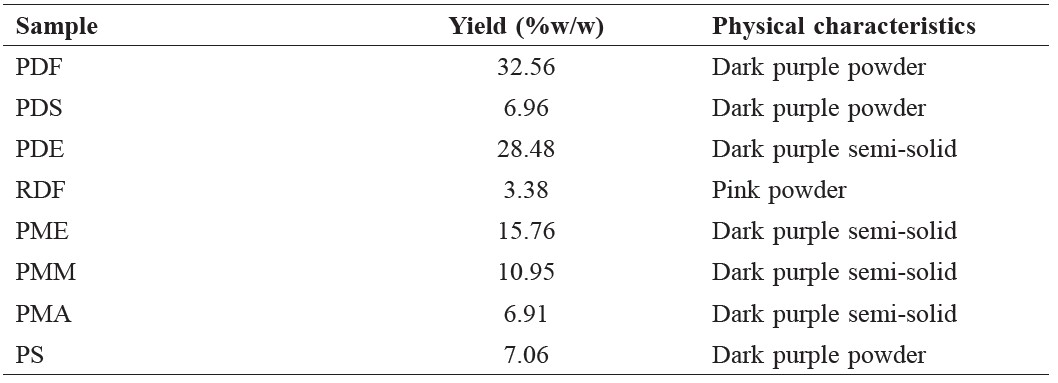
Free radical scavenging activity by DPPH scavenging assay Upon comparing the ripe fruit extracts of mamao prepared by various methods of extraction, the extract from the decoction promoted higher free radical scavenging activity than the maceration and squeezing extracts. No significant difference was observed between the free radical scavenging effects of the decoction extracts obtained from the various drying methods. The raw fruit extract also exhibited a high free radical scavenging effect (Table 3).
Determination of total phenolic content by folin-ciocalteu method
As demonstrated in Table 3, RDF exhibited the highest total phenolic content of 2.81 ± 0.88 g%GAE. The total phenolic content values of the extracts from the ripe fruits of mamao prepared using different methods of extraction ranged from 0.87 ± 1.00 g%GAE to 2.63 ± 1.02 g%GAE.
Determination of total anthocyanin content by pH differential method
The extract obtained by the method of squeezing the ripe fruits of mamao contained the highest amount of total anthocyanin content of 61.51 ± 0.95 g%C-3-GE (Table 3). The decoction extracts from the ripe fruits of mamao obtained by freeze drying and evaporation on a water bath contained significantly higher amounts of total anthocyanin content than the extract obtained from spray drying. The results suggest that the high temperature during the process of spray drying had a significant decreasing effect on the anthocyanin content.
Table 3. Free radical scavenging activity, total phenolic content, and total anthocyanin content of extracts from fruits of mamao prepared by different extracting and drying methods.

Note: PDF = ripe fruit decoction freeze drying extract, PDS = ripe fruit decoction spray drying extract, PDE = ripe fruit decoction water bath evaporating extract, RDF = raw fruit decoction freeze drying extract, PME = ripe fruit maceration ethanol extract, PMM = ripe fruit maceration methanol extract, PMA = ripe fruit maceration acetone extract, PS = ripe fruit squeezing extract. *Different letters in the same column indicate significant differences (p<0.05).
Thin Layer Chromatography (TLC) fingerprints of decoction extracts from ripe fruits of mamao
From the results, the decoction extracts of the ripe fruit of mamao with high DPPH scavenging activity, and high amounts of total phenolic content and total anthocyanin content, with preferable physical characteristics and yields, were analyzed for phytochemical characteristics by TLC. Thin layer chromatographs of decoction extracts from mamao fruits showed specific fingerprints with some dark quenching and fluorescence bands via the detection under UV 254 nm and 366 nm, respectively. The results suggest the presence of phytochemicals with chromophores, such as conjugated double bonds of phenolics and flavonoids. In addition, these compounds showed positive results to the DPPH spray reagent, appearing as pale yellow bands on purple background, thereby suggesting antioxidant effects (Figure 1). The compound that appeared at the Rf value of 0.74 was the major band, which also promoted antioxidant activity and could further be used as an antioxidant marker for the quality control of the mamao fruit extract. Mamao fruit extract prepared from decoction and evaporation on a water bath method (PDE) possessed relatively similar physical characteristics and antioxidant effects as the decoction extracts prepared by freeze drying and spray drying (PDF and PDS, respectively). However, the preparation method that was simple, convenient and economical, and thus most suitable for up-scaling in the manufacturing process, was selected for the development of readily dissolving powder.
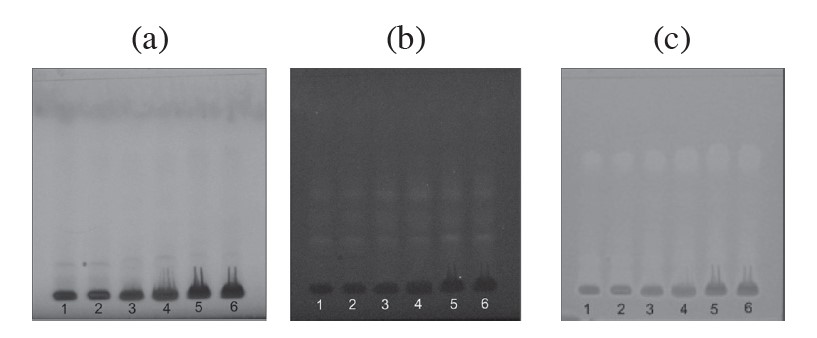
Figure 1. The TLC fingerprints of decoction extracts from the ripe fruit of mamao prepared by different drying methods; stationary phase: silica gel GF254, solvent system: n-butanol:glacial acetic acid:water (4:1:5), track: 1,2 = PDF; 3,4 = PDS; 5,6 = PDE; (a) UV 254nm, (b) = UV 366nm, (c) = DPPH spray reagent.
Product development
The physical characteristics of readily dissolving powder formulations of mamao fruit extract are presented in Table 4 and Figure 2. The readily dissolving powder formulation 2 promoted the product with a good physical appearance of pinkish-red powder with fast solubility in one glass of water (240 mL) to yield a reddish-brown drink with a sweet-sour taste. The products from formulations 1 and 4 were too sour, while formulation 3 was a pale pink color and yielded a dark brown solution, which may not be preferable to the customer.
Table 4. Physical characteristics of readily dissolving powder formulations of mamao fruit extract.

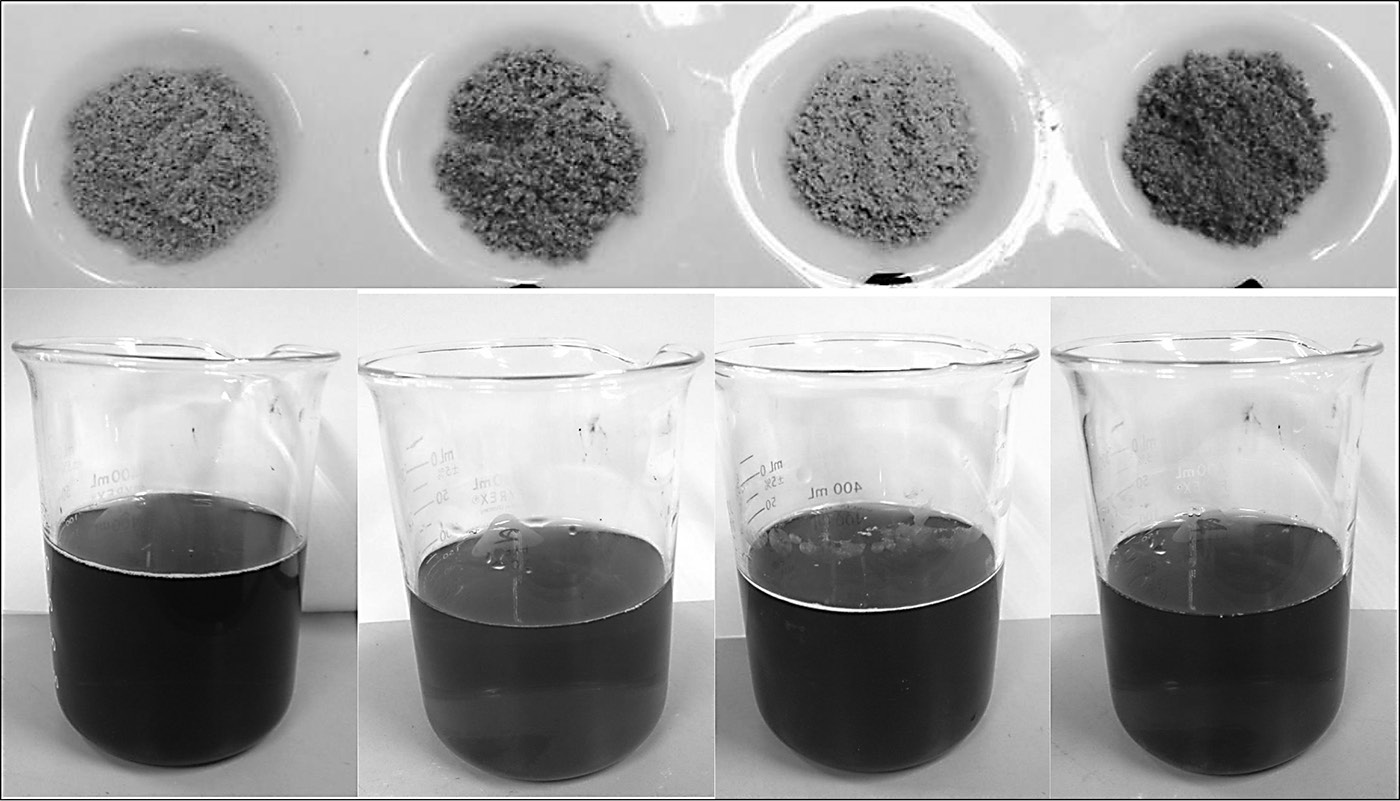
Figure 2. The physical characteristics of readily dissolving powder formulations of mamao fruit extract: upper rows = readily dissolving powders, lower rows = ready drinks; (a) = formulation 1, (b) = formulation 2, (c) = formulation 3, and (d) = formulation 4.
The percentage losses during drying of all the readily dissolving powder formulations of mamao fruit extract were acceptable, in the range of 0.15-0.25%. Using the IR spectroscopic technique (KBr disc), it was demonstrated that all the readily dissolving powder formulations of the mamao fruit extract promoted similar IR spectra with the peaks corresponding to chemical functional groups, including the hydroxyl group (OH), C-H group, keto group (C=O), C=C group and C-O group (Fresenius et al., 1989); the fingerprint of the benzene ring corresponded to the functional groups of phenolic and flavonoid compounds, as shown in Figure 3. The results from the IR analysis support the results from the TLC and spectrophotometric assays. The functional groups from the IR spectra of readily dissolving powder from mamao fruit extract are as illustrated in Table 5.
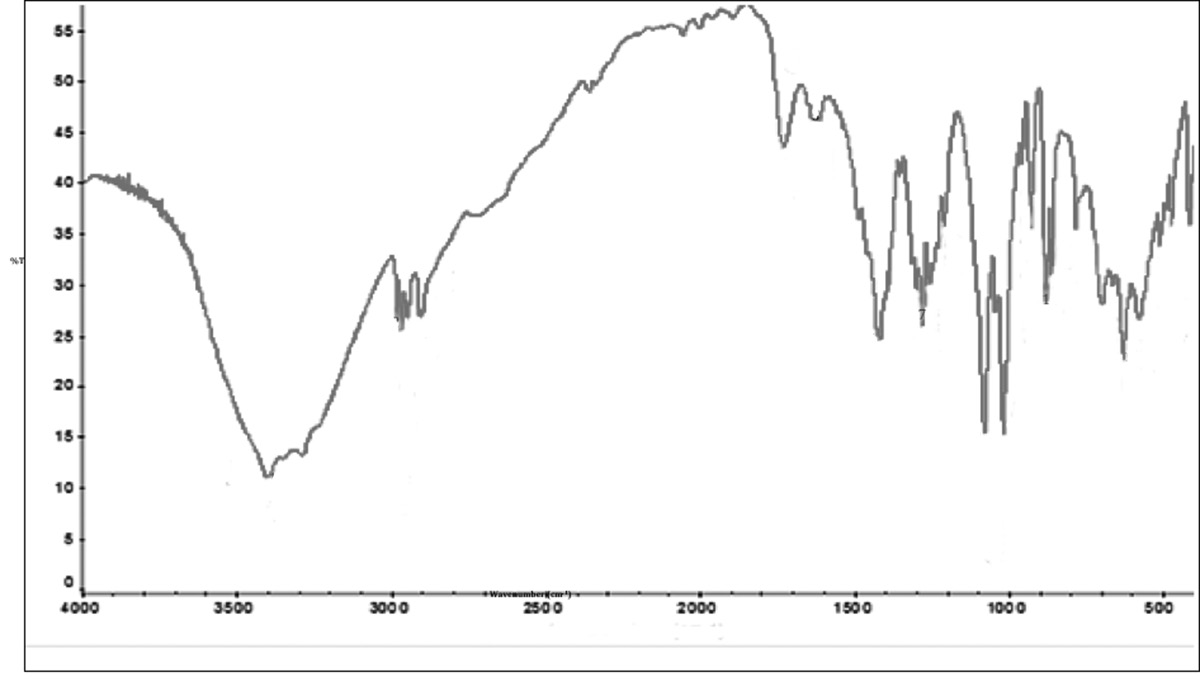
Figure 3. The IR spectra (KBr disc) of readily dissolving powder formulations of mamao fruit extract.
Table 5. IR spectra of readily dissolving powders from mamao fruit extract.
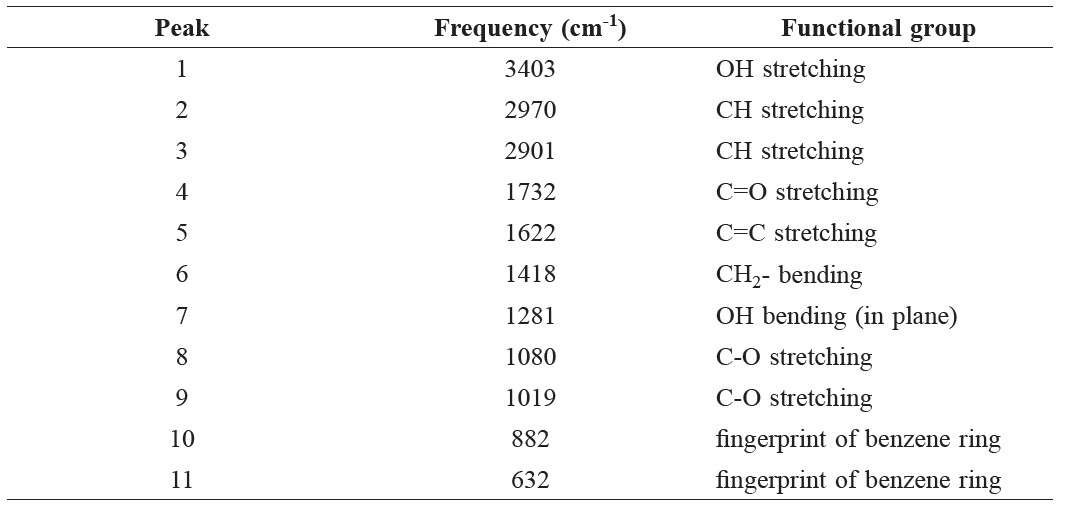
After the quantitative analysis of the anthocyanin content by the pH differential method, it was found that one sachet of 14 g of readily dissolving powder from mamao fruit extract formulation 2 contained 3.08 ± 0.81 g%C-3-GE. Upon analyzing with regard to the DPPH scavenging reaction, it was observed that one sachet of this readily dissolving powder exhibited free radical scavenging activity equivalent to 0.004 g of vitamin C, calculated from the standard curve of vitamin C obtained from the same assay, as shown in Figure 4. After dissolving one sachet of readily dissolving powder in one glass of water (240 ml), the solution appeared brownish red with a sour-sweet flavor.
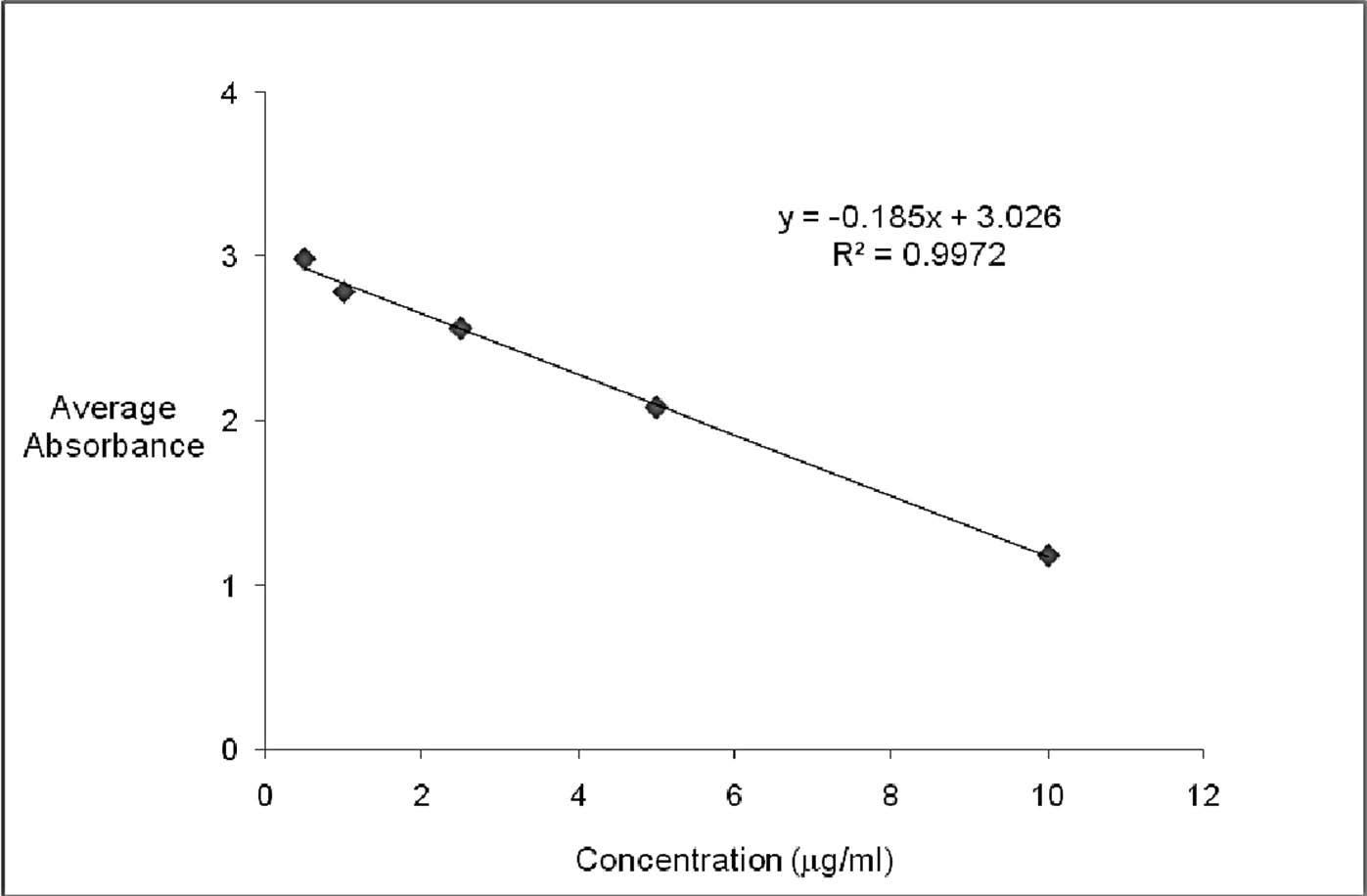
Figure 4. The standard curve of vitamin C obtained from the DPPH scavenging assay.
DISCUSSION
Mamao (Antidesma ghaesembilla) is a plant with edible fruits that can potentially be developed as a health supplement due to its antioxidant activity. The major chemical constituents in the fruit of mamao are phenolics and anthocyanins, which contribute to the deep purple color of the ripe fruits. Extraction by decoction produced an extract with stronger free radical scavenging activity and higher total phenolic content and total anthocyanin content than maceration with organic solvents, such as acetone, methanol and ethanol, or fresh squeezing with water. The results suggest that extraction with water at moderate temperature promoted the extraction of high amounts of antioxidant phenolic and anthocyanin compounds. This information corresponds to the study of Thanya et al. (2012), who pointed out that monomeric anthocyanin in rice was efficiently extracted with water at 50°C. Even though the decoction of the raw fruits of mamao promoted the highest anthocyanin content, it was observed to exhibit equally strong antioxidant activity as the other decoction extracts from the ripe fruits (purple fruits). The ripe fruits of mamao are far more abundant in markets than the raw fruits; therefore, the ripe fruits should be used as raw materials for product development.
All drying methods for preparing mamao fruit extract, including freeze drying, spray drying and evaporation on a water bath, yielded extracts with the same antioxidant activities and phenolic contents. However, spray drying produced an extraction with significantly lower amounts of anthocyanin content due to the high temperatures required. Crowe and Murray (2013) showed that grinding and heating in the production process of strawberry fruit juices and jams decreased the amount of phenolic and anthocyanin contents of the products. Heat in the production process also affected the phenolic content and antioxidant abilities of tea leaves (Areekul and Mettamethar, 2006; Kim et al., 2007). For these reasons, evaporation on a water bath is the drying method of choice because of its convenience, simplicity and cost, and also because it provides good quality mamao fruit extract.
The developed readily dissolving powder from the mamao fruit extract had preferable physical properties, including physical appearance, odor, solubility, taste and percentage loss during drying. This formulated readily dissolving powder of the mamao fruit extract was quality tested by TLC fingerprint, IR fingerprint, total anthocyanin content and antioxidant activity by DPPH scavenging assay. The developed readily dissolving powder from the mamao fruit extract exhibited a preferable in vitro antioxidant effect and contained high amounts of total phenolic content and total anthocyanin content. Another report about the antioxidant activities of local herbal drinks and teas in Thailand also suggested that herbal drinks from plants that contain phenolics and anthocyanins as major constituents, such as Indian gooseberry (Phyllanthus emblica), Terminalia chebula and red grapes (Vitis vinifera), promoted high antioxidant activities, as tested using DPPH scavenging assay (Prohmhirangul, 2008; Iamsaard et al., 2014). However, other chemical compositions in the formulation such as sucrose, citric acid and ascorbic acid affected the stability of the phenolic compounds in the instant herbal drink (Chen et al., 2001; Su et al., 2003). As is evident from all the data obtained in this experiment, this product has potential as a herbal drink for supporting health, along with other herbal teas from Thai medicinal plants. Further research, including phytochemical analysis of active components, stability tests, consumer preference studies of physical appearance, color, odor, taste and overall appeal (Pangaew et al., 2006), other related biological activity determinations, and toxicity tests should be performed. The customer testing results from Pangaew et al. (2006) suggested that the declaration of the health benefits of healthy herb tea mixed with soybean germ increased consumer acceptance and sales.
In conclusion, extract from the ripe fruits of mamao (Antidesma ghaesembilla) prepared by decoction and drying by evaporation on a water bath (PDE) promoted high antioxidant activity, which was tested by DPPH scavenging assay. This extract contained high amounts of phenolics and anthocyanins. Readily dissolving powder from PDE developed by wet granulation method appeared as a pinkish red powder, containing 3.08 ± 0.81 g%C-3-GE in one sachet (14 g), and exhibited free radical scavenging activity equivalent to 0.004 g of vitamin C. Thin layer chromatographic and infrared spectroscopic fingerprints and loss during drying tests were conducted to qualitatively control the specification of the product. Investigation for the stability, toxicity and other related biological
activities of the readily dissolving powder should be performed in the future. The results of this study could be useful as guidance for further development of antioxidant products from mamao fruit extracts in industrial enterprises.
ACKNOWLEDGMENTS
The authors would like to thank Mr. Paponpat Worasakungiat, Mr. Apirat Jamnonkoon, Ms. Sirothorn Prasertsang and Ms. Suthikarn Dachpornprateep for assistance in the laboratory. The authors would like to thank Mr. Panupon Khumsupan for his kind proofreading of the manuscript. The authors would also like to thank the Faculty of Pharmacy, Mahidol University, Center of Excellence in Herbal Medicine and Natural Products, The Office of the High Education Commission
and Mahidol University under the National Research Universities Initiative for their financial support.
REFERENCES
Areekul, V., and N. Mettamethar. 2005. The impact of manufacturing process on polyphenol content and antioxidant capacity of herbal tea infusion. The 8th Agro-Industrial Conference: 15-16 June 2005. Bangkok, Thailand.
Chen, Z.Y., Q.Y. Zhu, D. Tsang, and Y. Huang. 2001. Degradation of green tea catechins in tea drinks. Journal of Agricultural and Food Chemistry 49: 477-482. DOI: 10.1021/jf000877h
Cross, E.C. 1987. Oxygen radicals and human disease. Annals of Internal Medicine 107: 526-545.
Crowe, K.M., and E. Murray. 2013. Deconstructing a fruit serving: comparing the antioxidant density of select whole fruit and 100% fruit juices. Journal of the Academy of Nutrition and Dietetics 113(10): 1354-1358. DOI: 10.1016/j.jand.2013.04.024
Chanwitheesuk, A., A. Teerawutgulrag, and M. Rakariyatham. 2005. Screening of antioxidant activity and antioxidant compounds of some edible plants of Thailand. Food Chemistry 92: 491-497. DOI: 10.1016/j.foodchem.2004.07.035
Deetae, P., P. Parichanon, P. Trakunleewatthana, C. Chanseetis, and S. Lertsiri. 2012. Antioxidant and anti-glycation properties of Thai herbal teas in comparison with conventional teas. Food Chemistry 133: 953-959. DOI: 10.1016/j.foodchem.2012.02.012
Fresenius, W., J.F.K. Huber, E. Pungor, G.A. Rechnitz, W. Simon, and T.S. West., editors. Tables of spectral data for structure determinations of organic compounds. 2nd ed. Springer-Verlag: New York, USA, 1989.
Homhual S. Phargarden.com. Faculty of Pharmaceutical Sciences, Ubon Ratchathanee University. Available online: http://www.phargarden.com/main.php?action=viewpage&pid=95 [accessed on 9 February 2014].
Iamsaard, S., S. Arun, J. Burawat, W. Sukhorum, J. Wattanathorn, S. Nualkaew, and B. Sripanidkulchai. 2014. Phenolic contents and antioxidant capacities of Thai-Makham Pom (Phyllanthus emblica L.) aqueous extracts. Journal of Zhejiang University-SCIENCE B (Biomedicine & Biotechnology) 15(4):405-408. DOI: 10.1631/jzus.B1300284
Kermath, B.M., B.C. Bennett, and L.M. Pulsipher. 2014. Food Plants in the Americas. Availabel online: http://www.academia.edu [accessed on 25 January 2015].
Kim, E.S., Y.R. Liang, J. Jin, Q.F. Sun, J.L. Lu, Y.Y. Du, and C. Lin. 2007. Impact of heating on chemical compositions of green tea liquor. Food Chemistry 103: 1263-1267. DOI: 10.1016/j.foodchem.2006.10.031
Kruawan, K., and K. Kangsadalampai. 2006. Antioxidant activity, phenolic compound contents and antimutagenic activity of some water extract of herbs. Thai Journal of Pharmaceutical Sciences 92: 28-35.
Maisuthisakul, P., M. Suttajit, and R. Pongsawatmanit. 2007. Assessment of phenolic content and free radical-scavenging capacity of some Thai indigenous plants. Food Chemistry 100: 1409-1418. doi : 10.1016/j.foodchem.2005.11.032
Neamsuvan, O., T. Tuwaemaengae, F. Bensulong, A. Asae, and K. Mosamae. 2012. A survey of folk remedies for gastrointestinal tract diseases from Thailand’s three southern border provinces. Journal of Ethnopharmacology 144: 11-21. DOI: 10.1016/j.jep.2012.07.043
Naithani, J., S. Nair, and P. Kakkar. 2005. Decline in antioxidant capacity of Indian herbal teas during storage and its relation to phenolic content. Food Research International 39: 176-181. doi : 10.1016/j.foodres.2005.07.004
Pangaew, K., S. Lertworasirikul, W. Harutaithanasan, W. Tanapat. 2006. Development of healthy herb tea mixed with soybean germ. The Proceedings of the 44th Kasetsart University Annual Conference, Kasetsart, 30 January - 2 February, 2006 Subject: Agro industry, Economics, Business Administration: 378-385.
Prohmhirangul, P. 2008. Evaluation of antioxidant activity in Thai herbal beverages and wines. Maharat Nakhon Ratchasima Hospital Medical Bulletin 32: 101-108.
Sithisarn, P., S. Muensaen, and S. Jarikasem. 2011. Determination of caffeoyl quinic acids and flavonoids in Acanthopanax trifoliatus leaves by HPLC. Natural Product Communications 6(9):1289-1291. DOI:10.1159/000226294
Sithisarn, P. and S. Jarikasem. 2009. Antioxidant activity of Acanthopanax trifoliatus. 2009. Medical Principles and Practice 18(5): 393-398.
Su, Y.L., L.K. Leung, Y. Huang, and Z.Y. Chen. 2003. Stability of tea theaflavins and catechins. Food Chemistry 83: 189-195. DOI: 10.1016/S0308-8146(03)00062-1
Sutharut, J., and J. Sudarat. 2012. Total anthocyanin content and antioxidant activity of germinated colored rice. International Food Research Journal 19(1): 215-221.
Thanya, K., S. Lapanantnoppakhun, M. Julsiri, C. Prom-u-thai, and K. Grudpan. Study on solubility factors of rice’s water-soluble phenolic compounds. Extended abstracts of the 2nd national rice research conference, Bangkok, Thailand, 2012: 510-513.
United States Pharmacopoeia Commission. USP36/NF31. U.S. Pharmacopeia, Rockville, USA. 2013.
Yamasaki, K., A. Hashimoto, Y. Kokusenya, T. Miyamoto, and T. Sato. 1994. Electrochemical method for estimating the antioxidative effects of methanol extracts of crude drugs. Chemical and Pharmaceutical Bulletin 42(8): 1663-1665.
Pongtip Sithisarn1,2*, Wandee Gritsanapan1,2 and Somboon Jateleela3
1 Department of Pharmacognosy, Faculty of Pharmacy, Mahidol University, Bangkok 10400, Thailand
2 Center of Excellence in Herbal Medicines and Natural Products, Faculty of Pharmacy, Mahidol University, Bangkok 10400, Thailand
3 Department of Manufacturing Pharmacy, Faculty of Pharmacy, Mahidol University, Bangkok 10400, Thailand
*Corresponding author. E-mail: pongtip.sit@mahidol.ac.th
Total Article Views

